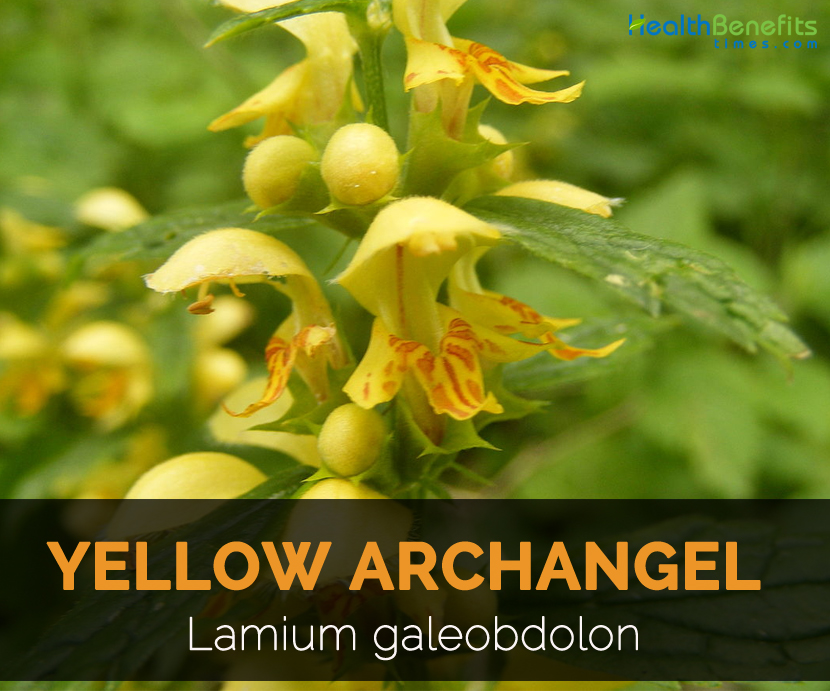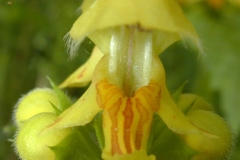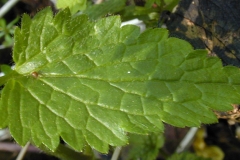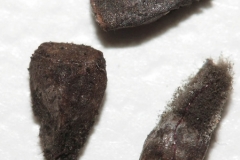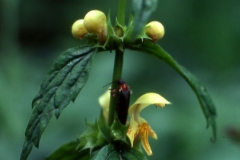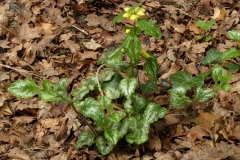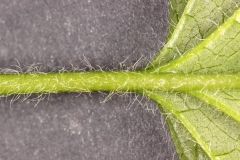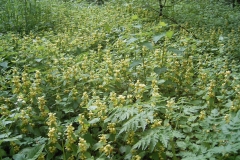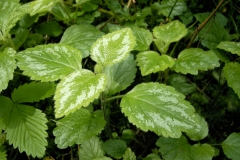Description:
It is a large leaved perennial plant having underground runners which grows to the height of 40 to 80 cm. Leaves are broadly ovate having cordate base and toothed margin. Leaves have purplish underside. Flowers form in whorls in terminal spike. Calyx is five lobed. Corolla is 15 to 25 mm long, yellow and petals are fused with long tube and two lips. Upper lip is hooded and lower lip has 3 similar sized lobes having central one triangular and streaked with orange. There are two long stamens and two short stamens. Carpels are fused and fruit is a four chambered schizocarp.
Flowers
Flowers are small, yellow forming as whorls in leaf axils. It consists of five modified petals forming two lipped blood with pale yellow upper petals and yellow lower petals having orange to brown markings. Flower blooms in spring from April-June.
Stems
Stems are erect; four sided or square measuring 30 cm and grows to 60 cm tall. It has perennial stems producing stolons growing horizontally.
Leaves
Leaves are oval to heart shaped having round toothed margins. It is variegated dark green in color with silver contour along outer margin. Typically yellow archangel is evergreen except in colder climates.
Medicinal uses:
- Tea prepared from Yellow archangel is useful for menstrual and abdominal complaints if two cups are sipped during the day.
- It cleanses the blood and is an effective remedy for sleeplessness and for diverse female troubles.
- People suffering from continual abdominal complaints and young girls are said to be benefited by this tea.
- The leaves and flowers of the yellow archangel are used for scanty or burning urine, bladder trouble, serious kidney disorders and fluid retention in the heart.
- The flowers are used for digestive troubles, scrofula and skin rashes when it is recommended that one cup of this tea should be drunk during the morning.
- For ulcers and varicose veins, compresses made from the infusion are beneficial.
- Yellow archangel can be recommended for bladder malfunction with older people, as well as for chill in the bladder and nephritis.
Culinary uses
- Shoots and young leaves are cooked.
- Flowering tips (young) are cooked.
References:
https://davesgarden.com/guides/pf/go/51501/
https://pfaf.org/user/Plant.aspx?LatinName=Lamium+galeobdolon
http://www.missouribotanicalgarden.org/PlantFinder/PlantFinderDetails.aspx?kempercode=d710
https://en.wikipedia.org/wiki/Lamium_galeobdolon
Comments
| Yellow Archangel Quick Facts | |
|---|---|
| Name: | Yellow Archangel |
| Scientific Name: | Lamium galeobdolon |
| Colors | Brown |
| Shapes | 4-parted schizocarp |
| Name | Yellow Archangel |
|---|---|
| Scientific Name | Lamium galeobdolon |
| Native | Europe and found through Europe and Western Asia |
| Common/English Name | Yellow deadnettle, yellow archangel, dummy nettle, weazel snout, dummy nettle |
| Name in Other Languages | German: Echte Goldnessel, Gewöhnliche Goldnessel; Swedish: Gulplister; Dutch: Gele dovenetel; English: Yellow archangel; French: Lamier à fleurs jaunes, Lamier vagabond, Lamier jaune, Ortie jaune; Hungarian: Sárga árvacsalán; Japanese: Ramiumu gariobudoron (ラミウムガリオブドロン); Russian: Zelenchuk zheltyy (Зеленчук желтый) |
| Plant Growth Habit | Herbaceous perennial |
| Soil | Dry to medium moisture, well-drained |
| Plant Size | 20-40 cm (8-16 inches) high |
| Stem | Square |
| Leaves | Bronze, Dark/Black, opposite |
| Flowering Season | Late Spring/Early Summer |
| Flower | Bright Yellow, 15-25 mm (0.6-1 inches) long |
| Fruit shape & size | 4-parted schizocarp |
| Fruit color | Small brown |


